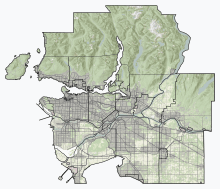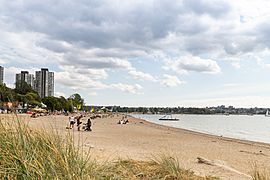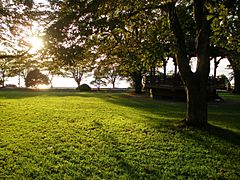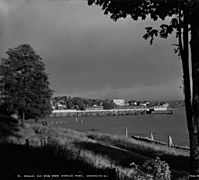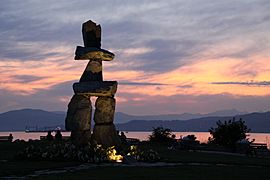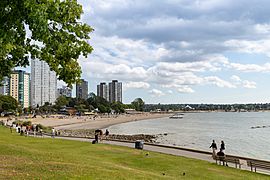English Bay, Vancouver facts for kids
English Bay is a beautiful bay located in Vancouver, British Columbia, Canada. It sits just west of the city's downtown area and False Creek. The bay is part of the larger Burrard Inlet and stretches from Point Grey in the southwest to Prospect Point in the northeast. It's a very popular spot for both locals and visitors to enjoy the outdoors.
Contents
Exploring English Bay's Beaches
English Bay Beach is a famous spot in Vancouver's West End neighborhood. It's a favorite place for sunbathing, swimming, and watching amazing sunsets. Other popular beaches facing English Bay include Sunset Beach, Second Beach, and Third Beach.
On the south side of the bay, you'll find Kitsilano Beach, Jericho Beach, Locarno Beach, and the Spanish Banks beaches. Across the bay, on the North Shore, are Ambleside Beach and smaller beaches in West Vancouver. These beaches attract many tourists all year, especially in late summer.
The Vancouver Seawall
The Vancouver Seawall is a long path that goes all the way around English Bay. It starts at Stanley Park and continues around False Creek to Point Grey, facing the Strait of Georgia. This path is perfect for walking, running, biking, and rollerblading. If you're cycling or rollerblading, remember it's one-way, going counter-clockwise from near the Lions Gate Bridge to Third Beach.
Fun Events at English Bay
English Bay Beach hosts many exciting public events throughout the year.
Celebration of Light Fireworks
Every summer, usually in late July and early August, English Bay is home to the Celebration of Light. This is a huge fireworks competition where different countries put on amazing displays. It's one of the biggest offshore fireworks shows in the world and has been happening since 1990.
Winter Swims and Summer Parades
In the winter, the bay hosts Vancouver's yearly Polar Bear Swim. Brave people jump into the cold ocean on New Year's Day! In the summer, the Vancouver Pride Parade and Festival also takes place on English Bay Beach, celebrating diversity and inclusion.
A Look Back at English Bay's Past
In the late 1800s and early 1900s, English Bay Beach had Vancouver's first official lifeguard, a legendary person named Joe Fortes. He taught many early residents of the city how to swim and watched over the beach from his small cabin.
Today, you'll often see many small pleasure boats in the bay. You might also spot huge cargo ships waiting to load goods at Vancouver's port.
The 2015 Oil Spill
On April 8, 2015, there was an oil spill in English Bay. About 2,700 liters of fuel leaked from a cargo ship into the bay. This oil later washed up on nearby beaches. Some seabirds were affected by the spill. After the spill, the beaches were tested and most were reopened after about ten days. Officials advised people to be careful and avoid touching any small amounts of oil that might still be present. The beaches continued to be checked for any remaining oil.
Gallery
-
Sunset on the inuksuk at English Bay
See also
 In Spanish: Bahía Inglesa (Vancouver) para niños
In Spanish: Bahía Inglesa (Vancouver) para niños



